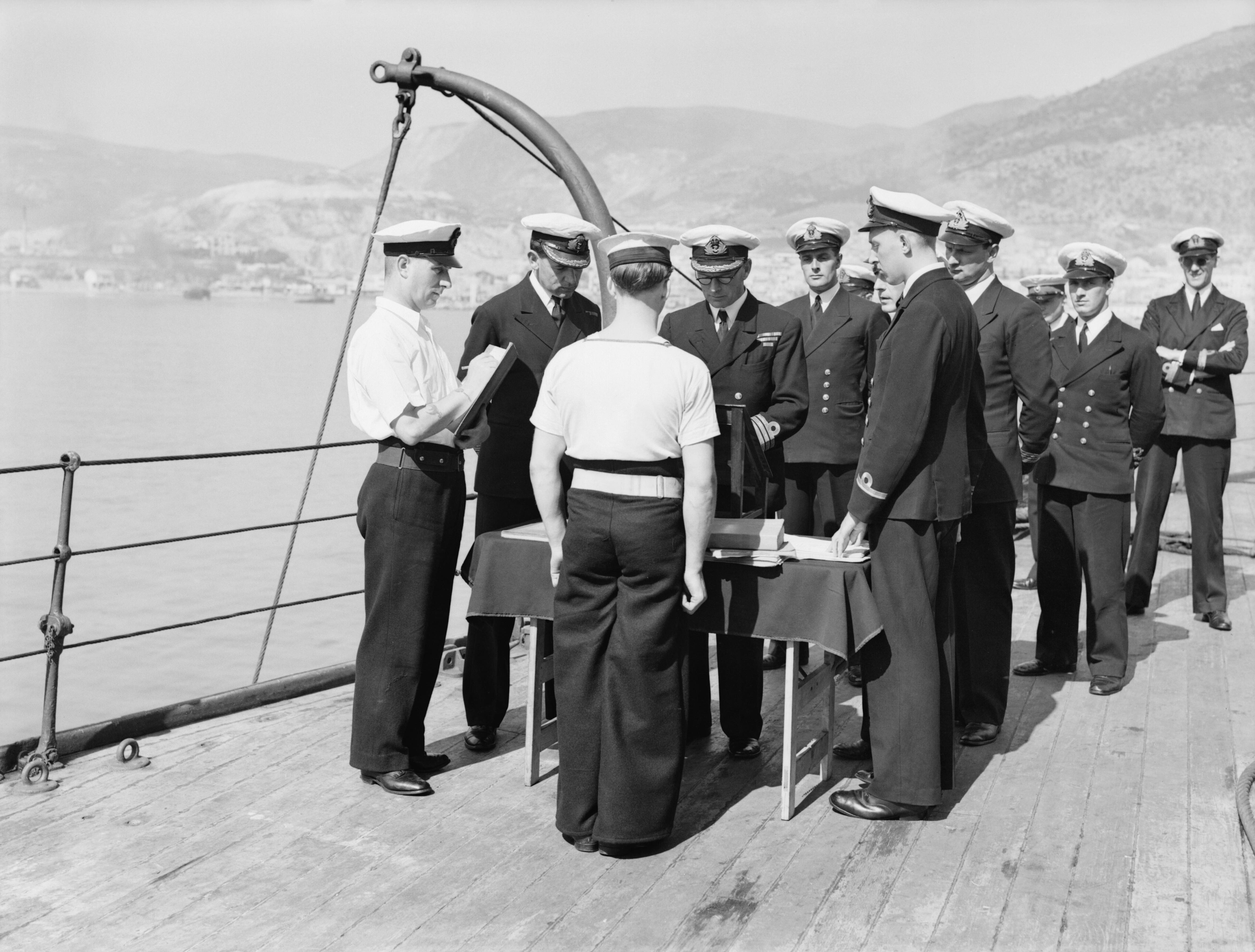Master-at-Arms on:
[Wikipedia]
[Google]
[Amazon]
A Master-at-Arms (US: MA; UK & some Commonwealth: MAA) may be a naval rating, responsible for

law enforcement
Law enforcement is the activity of some members of government who act in an organized manner to enforce the law by discovering, deterring, rehabilitating, or punishing people who violate the rules and norms governing that society. The term ...
, regulating duties, security, anti-terrorism/force protection (AT/FP) for/of a country's navy
A navy, naval force, or maritime force is the branch of a nation's armed forces principally designated for naval and amphibious warfare; namely, lake-borne, riverine, littoral, or ocean-borne combat operations and related functions. It in ...
; an army officer responsible for physical training; or a member of the crew of a merchant ship
A merchant ship, merchant vessel, trading vessel, or merchantman is a watercraft that transports cargo or carries passengers for hire. This is in contrast to pleasure craft, which are used for personal recreation, and naval ships, which are ...
(usually a passenger vessel) responsible for security and law enforcement. In some navies, a ship's corporal is a position—not the rank—of a petty officer
A petty officer (PO) is a non-commissioned officer in many navies and is given the NATO rank denotation OR-5 or OR-6. In many nations, they are typically equal to a sergeant in comparison to other military branches. Often they may be super ...
who assists the master-at-arms in his various duties. Historically, a master-at-arms was responsible for the training of soldiers during peace time, or actively involved in leading the defense of a fortification during war time.
In some countries, the term "Navy Police" is used for an institution part of a navy responsible for law enforcement
Law enforcement is the activity of some members of government who act in an organized manner to enforce the law by discovering, deterring, rehabilitating, or punishing people who violate the rules and norms governing that society. The term ...
, such as the Royal Navy Police, known as the Royal Navy Regulating Branch until 2007.
South Africa
United Kingdom

Royal Navy
The master-at-arms (MAA) is a ship's senior rating, normally carrying the rank of chief petty officer or warrant officer. They are in charge of discipline aboard ship, assisted by regulators of the Royal Navy Police, of which they are a member. The non-substantive (trade) badge of an MAA is a crown within a wreath. The post of master-at-arms was introduced to the Royal Navy during the reign of King Charles I; their original duties were to be responsible for the ship's small arms and edged weapons, and to drill the ship's company in their use. This was not an onerous task, and masters-at-arms came to be made responsible for "regulating duties"; their role as weapons instructors was eventually taken over by the chief gunner. The MAA is addressed as "Master" if holding the rank of chief petty officer, regardless of gender, and is often nicknamed the "jaunty", a corruption of the French gendarme, or the "joss/jossman". As a result of theArmed Forces Act 2006
The Armed Forces Act 2006 (c 52) is an Act of the Parliament of the United Kingdom.
It came into force on 31 October 2006. It replaces the three separate Service Discipline Acts (the Army Act 1955, the Air Force Act 1955 and the Naval Discip ...
, the term Regulating Branch was changed to Service Police and the branch title changed to the Royal Navy Police and reported to their respective service's Provost Marshal
Provost marshal is a title given to a person in charge of a group of Military Police (MP). The title originated with an older term for MPs, '' provosts'', from the Old French ''prévost'' (Modern French ''prévôt''). While a provost marshal i ...
, who was responsible to the First Sea Lord
The First Sea Lord and Chief of the Naval Staff (1SL/CNS) is the military head of the Royal Navy and Naval Service of the United Kingdom. The First Sea Lord is usually the highest ranking and most senior admiral to serve in the British Armed Fo ...
.
British Army
In theBritish Army
The British Army is the principal land warfare force of the United Kingdom, a part of the British Armed Forces along with the Royal Navy and the Royal Air Force. , the British Army comprises 79,380 regular full-time personnel, 4,090 Gurkha ...
, a master-at-arms is an officer
An officer is a person who has a position of authority in a hierarchical organization. The term derives from Old French ''oficier'' "officer, official" (early 14c., Modern French ''officier''), from Medieval Latin ''officiarius'' "an officer," f ...
of the Royal Army Physical Training Corps
The Royal Army Physical Training Corps (RAPTC) is the British Army corps responsible for physical fitness and physical education and has been headquartered in Aldershot since its foundation in 1860. Its members are all Royal Army Physical Trainin ...
, posted as an SO2 or SO3 at divisional headquarters or higher command, and responsible for overseeing all fitness training in subordinate units. The role is filled by RAPTC WO1s at brigade headquarters, while WO2s or staff sergeant
Staff sergeant is a rank of non-commissioned officer used in the armed forces of many countries. It is also a police rank in some police services.
History of title
In origin, certain senior sergeants were assigned to administrative, superv ...
PTIs are embedded at unit level.
United States Navy
In theUnited States Navy
The United States Navy (USN) is the maritime service branch of the United States Armed Forces and one of the eight uniformed services of the United States. It is the largest and most powerful navy in the world, with the estimated tonnage ...
, the master-at-arms rating is responsible for law enforcement, investigations, K-9, expeditionary, and anti-terrorism/force protection operations. It is one of the oldest ratings in the United States Navy, having been recognized since the Navy's inception.
References
{{reflist Royal Navy specialisms Military provost ranks